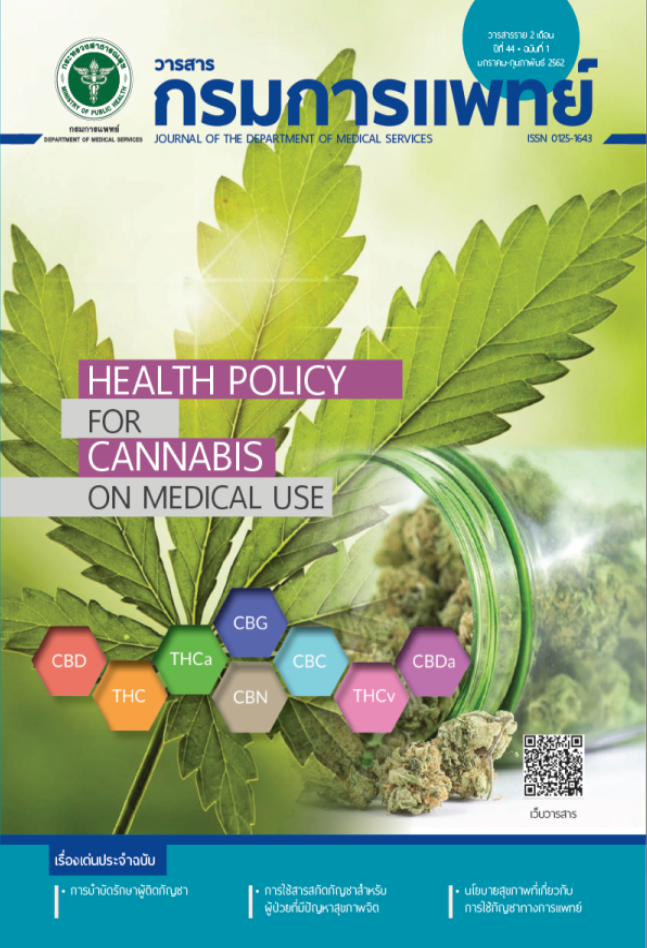ผลของดนตรีบำบัดในเด็กสมองพิการ : การทบทวนอย่างเป็นระบบ
คำสำคัญ:
ดนตรีบำบัด, สมองพิการบทคัดย่อ
ภูมิหลัง: การใช้ดนตรีบำบัดเพื่อให้ผลในทางสุขภาพและพฤติกรรมนั้นมีมาตั้งแต่ครั้งโบราณกาล แต่เริ่มมีการบันทึกเป็นลายลักษณ์อักษรในช่วงศตวรรษที่ 18 ดนตรีบำบัดในปัจจุบันเป็นที่รู้จักและมีหลักสูตรการเรียนการสอนที่เป็นมาตรฐานในระดับมหาวิทยาลัยหลายแห่งทั่วโลก มีการนำมาใช้เพื่อผลทั้งทางด้านร่างกาย จิตใจ และสังคม จากหลักฐานทางงานวิจัยในปัจจุบันแสดงให้เห็นว่าเมื่อใช้ดนตรีบำบัดร่วมกับการให้การรักษาทางคลินิกอื่นๆ จะส่งผลให้การรักษานั้นๆ มีประสิทธิภาพมากยิ่งขึ้น เช่น การฝึกกำลังกล้ามเนื้อด้วยการออกกำลังกายตามจังหวะดนตรี การลดความวิตกกังวลจากการผ่าตัดด้วยการฟังดนตรี เป็นต้น นอกจากนี้ดนตรีบำบัดยังจัดว่าเป็นการรักษาที่มีความปลอดภัยสูงและมีต้นทุนต่ำ ซึ่งนักวิชาชีพที่ผ่านการอบรมและฝึกฝนสามารถนำมาใช้ให้เกิดประโยชน์ต่อผู้รับบริการได้ ปัจจุบันมีการใช้ประโยชน์จากดนตรีบำบัดในกลุ่มเด็กสมองพิการมากขึ้น แต่พบว่ายังไม่เคยมีการทบทวนอย่างเป็นระบบ การรวบรวมความรู้และแนวทางการนำมาใช้ที่เป็นปัจจุบันจึงมีความจำเป็นและสามารถเพิ่มความหลากหลายในการนำไปใช้ให้กับนักวิชาชีพผู้ปฏิบัติ นอกจากนี้ยังเป็นจุดเริ่มต้นในการศึกษาวิจัยหรือรวบรวมข้อมูลเพื่อนำไปใช้ในผู้รับบริการกลุ่มอื่นๆ ด้วย วัตถุประสงค์: เพื่อศึกษาผลของดนตรีบำบัดต่อเด็กสมองพิการ วิธีการ : สืบค้นข้อมูลทางอิเล็กทรอนิกส์ จากฐานข้อมูล MEDLINE ผ่าน PubMed โดยเลือกเฉพาะการศึกษาที่เป็น Randomized controlled trials (RCTs) และมีการตีพิมพ์เป็นภาษาอังกฤษเท่านั้น ผล: การให้ดนตรีบำบัดช่วยเพิ่มผลลัพธ์ทางการรักษาในทั้ง 5 การศึกษา สรุป: การศึกษาผลของการใช้ดนตรีบำบัดต่อกลุ่มเด็กสมองพิการยังมีจำนวนน้อย และยังไม่เคยมีการนำมาทบทวนอย่างเป็นระบบ (Systematic reviews) การศึกษาที่รวบรวมได้ในครั้งนี้จำนวนทั้งหมด 5 การศึกษา ถึงแม้จะเป็นการทำการทดลองในกลุ่มตัวอย่างเดียวกัน แต่ไม่สามารถนำมาจัดแบ่งกลุ่มเพื่อสรุปข้อมูลได้ เนื่องจากทุกการศึกษามีความแตกต่างกันทั้งชนิดของ การรักษา และผลลัพธ์ของการศึกษา ดังนั้นจึงควรมี วารสารกรมการแพทย์74การทำการศึกษาผลของดนตรีบำบัดในเด็กสมองพิการในรูปแบบงานวิจัยที่เป็นปฐมภูมิ (Primary research) มากขึ้น เพื่อให้มีจำนวนการศึกษาที่เพียงพอสำหรับนำมาใช้วิเคราะห์ผลในรูปแบบการศึกษาชนิด RCTs ได้ รวมทั้งสามารถกำหนดชนิดการรักษาที่ต้องการทบทวน เพื่อให้ได้ผลลัพธ์ที่เฉพาะเจาะจงมากยิ่งขึ้น
References
Chan Thita Pruksananon. Cerebral Palsy: CP. In: Pairat Prasong Chinese, Editor. Cerebral Palsy. 1 edition. 2010: 1.
Darrow A. Introduction to Approaches in Music Therapy. 2nd ed. American Music Therapy Association, 2008.
Abromeit D, Colwell C.. Medical Music Therapy for Pediatrics in Hospital Settings. 1st ed. Vol. 1. Missouri. American Music Therapy Association, 2008. p. 3-7.
Standley J, Whipple J. Music Therapy for Premature Infants in the Neonatal Intensive Care Unit: Health and Developmental Benefits. In Music Therapy in Pediatric Healthcare Research and Evidence-Based Practice. The American Music Therapy Association, 2003; 19-28.
Naylor K, Kingsnorth S, Lamont A, McKeever P, Macarthur C. The effectiveness of Music in Pediatric Healthcare: A Systematic Review of Randomized Controlled Trials. Hindaxi Publishing Corporation, 2011.
Higgins JP, Thomson SG, Deeks JJ, Altman DG. Measuring inconsistency in meta-analyses. BMJ 2003; 327 (7414): 557-560.
Kim SJ, Kwak EE, Park Es, Cho SR. Differential effects of rhythmic auditory stimulation and neurodevelopmental treatment /Bobath on gait patterns in adults with cerebral palsy: a randomized controlled trial. Clinical rehabilitation 2012; 26(10): 904-14.
Peng YC, Lu TW, Wang TH, Chen YL, Liao HF, Lin KH, et al. Immediate effects of therapeutic music on loaded sit-to-stand movement in children with spastic diplegia. Gait & posture 2011; 33(2): 274
Wang TH, Peng YC, Chen YL, Lu TW, Liao HF, Tang PF, et al. A home-based program using patterned sensory enhancement improves resistance exercise effects for children with cerebral palsy: a randomized controlled trial. Neurorehabilitation and neural repair 2013; 27(8): 684-94.
Yu H, Liu Y, Wu L. Acupuncture combined with music therapy for treatment of 30 cases of cerebral palsy. Journal of traditional Chinese medicine 2009; 29(4): 243-8.
Yu H, Liu Y, Li S, Ma X. Effects of music on anxiety and pain in children with cerebral palsy receiving acupuncture: a randomized controlled trial. International journal of nursing studies 2009; 46(11): 1423-3.
Bjornson KF, Belza B, Kartin D, Logsdon R, McLaugh-lin JF. Ambulatory physical activity performance in youth with cerebral palsy and youth who are developing typically. Physical Therapy 2007; 87: 248-257.
Dyrlund AK, Wininger SR. The effects of music preference and exercise intensity on psychological variables. Journal of Music Therapy.2008; 45:114-134.
Thaut MH, Kenyon GP, Hurt CP, McIntosh GC, Hoemberg V. Kinematic optimization of spatiotemporal patterns in paretic arm training with stroke patients. Neuropsychologia. 2002; 40: 1073-1081.
Thaut MH. Rhythm, music, and the brain. Scientific foundations and clinical applications. London: Routledge, 2008
Downloads
เผยแพร่แล้ว
How to Cite
ฉบับ
บท
License
บทความที่ได้รับการตีพิมพ์เป็นลิขสิทธิ์ของกรมการแพทย์ กระทรวงสาธารณสุข
ข้อความและข้อคิดเห็นต่างๆ เป็นของผู้เขียนบทความ ไม่ใช่ความเห็นของกองบรรณาธิการหรือของวารสารกรมการแพทย์


